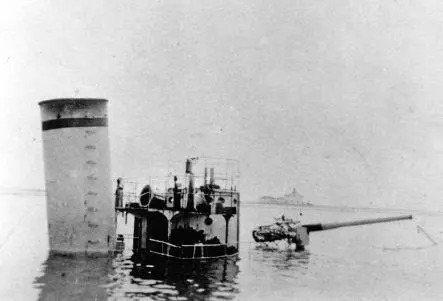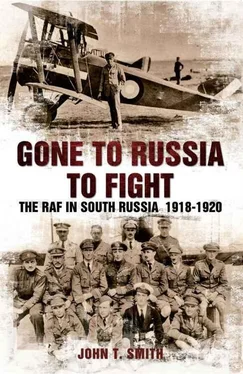In general, the weather for most of the month was unsuitable for long-range flying. The weather had now warmed up, but it was high wind and fog that limited flights. Nonetheless, on 14 May the first raid by a single DH9A from Petrovsk took place. The main Bolshevik fleet had left the Astrakhan area, but an armed tug towing a barge was bombed and driven ashore. An armed trawler was also bombed and machine-gunned from 700 ft.
Four DH9s left Petrovsk on 15 May for Chechen Island. One of the aircraft crashed on landing and burned out. The pilot, Lieutenant B. E. Nelson-Turner, and the observer, Second Lieutenant G. E. Jemmeson, were both killed. D. B. Knock wrote about the crash in his diary:
16/5/19 Tragic day. Lieutenant Nelson-Turner and Obs. Lieutenant Jemmeson crash in a DH9 landing at Chechen. Went up in flames and had no hope. Rotten to think that Nelson-Taylor finished like that. He was frank to me at times that he hadn’t the nerve he possessed when passing out at flying school at home. Am told that they must have been killed by the impact before the fire as it was a very bad smash-up. [4]
It seems unlikely that an officer would have confided in an other rank in this way, but morale did seem to be declining generally the longer the squadron was in Russia:
10/5/19 Mass meeting of O.Rs. and soap box oratory by two who take a vote on a decision ‘that the C. O. shall immediately through the Wing Commander communicate with the Air Ministry to ask what steps are being taken for relief of squadron’. Would be glad to get home myself. [5]
Most of the servicemen who had volunteered or been conscripted for the First World War had now been demobbed, and the forces in south Russia, men who had not seen their families for years, were not pleased with the thought that all the postwar jobs would have been filled by the time they finally arrived home.
In his diary, Knock added:
29/5/19 Commodore commanding Caspian naval forces [Commodore Norris] addresses parade and appeals to us to carry on in the interests of humanity and peace of the world.
30/5/19 Mosquitoes taking toll. Chronic fevers attacking many fellows. My legs and arms a mass of bites. But lucky so far… We are asked to volunteer for service with General Denikin as instructors in the Russian Volunteer Aviation Service. No response. Everybody getting fed up. [6]
At a later date, a number of the officers did volunteer to continue to serve in south Russia.
The Red ships that had left Astrakhan were finally located at Fort Alexandrovsk, on the eastern shore of the Caspian. A raid was mounted on this fleet by DH9As from Petrovsk on 18 May. A large number of ships were found, but no direct hits were observed. One of the aircraft was hit by machine-gun fire, but returned safely. As more DH9As were becoming available, the DH9s were being handed over to the White Russian air force. Several reconnaissance flights were carried out from Chechen Island along the coast north of the island. Ships that had been landing Red troops behind the front line were bombed. Lieutenant Leavsley crashed one of the DH9s (number D2797) on 20 May, the seventh DH9 lost.
A major naval engagement took place in Alexandrovsk on 21 May, as described later. No ships were found in Fort Alexandrovsk when a reconnaissance was carried out on 26 May and a bombing raid of the Astrakhan area by five DH9s from Chechen Island on 27 May revealed the fact that most of the fleet had returned to Astrakhan. Shipping in the main channel was bombed, as were buildings at Harbay. Lieutenant John Brayne Lynch, one of the pilots in 221 Squadron, wrote in his log-book:
27/5/19 08.20hrs. DH9 2958, Observer Lt. Gould, Time in Air 3hrs. 30mins. Height 5,000 ft. Carrying 8 16lb and 2 100lb bombs. Lt. Borth returned with engine trouble. Sighted Bolshevik fleet off Delta. (Comprising TBDs MLs and tugs.) 30 strong. Bombed and machine gunned them. 1 submarine sighted 5 miles S W of force. [7]
Demonstration flights continued over the surrounding villages and leaflets were dropped. Four aircraft trying to reach Astrakhan were turned back by bad weather on 30 May. The DH9As carried out another raid on Astrakhan on 31 May. Shipping, tugs, and barges were bombed. The main fleet was not seen, leading to the conclusion that it must have gone farther up the Volga. Several of the aircraft were hit by AA fire. Bombing raids to Astrakhan from Petrovsk, incidentally, involved a flight of 520 miles, mostly over water.
It was also during May that 266 Squadron began to join 221 Squadron in combat sorties around the Caspian. On 1 May, Lieutenant Bilney was posted to command A Flight of 266 Squadron, with the acting rank of Captain. The Wing diary for 1 May reads:
Seaplane while on patrol from Chechen to 12 foot anchorage, sighted in S. I. a steam tug towing three large barges proceeding W. S. W., barges apparently carrying troops. These were bombed, bombs falling within 20 feet of barges. Fire with machine gun was opened on barges. Numerous local flights carried out. [8]
Other reconnaissance flights were flown on 4, 6, and 8 May, but nothing was seen. A major ammunition convoy for the Ural Cossacks was escorted from Petrovsk to Guryev on 7 May, but again no Red ships were sighted.
Sketch map showing the situation in Fort Alexandrovsk harbour after the last raid by Short 184s on 22 May 1919. Based on a map drawn by a 184 observer.
221 Squadron aircraft dropping bombs on shipping at Harbay on the River Volga, close to Astrakhan.

A sunken Bolshevik destroyer photographed after the attack on 21 May 1919 at Fort Alexandrovsk.
On the morning of 12 May, the seaplane carrier Alader Youssanoff , equipped with two Short 184 seaplanes (numbers N9080 and N9082), left Petrovsk.. The Short 184s were large, ungainly aircraft used to carry out low-level machine-gun attacks and support British shipping. Captain Bilney left the following description of the Alader Youssanoff :
This ship was a merchantman, and by clearing the fore deck and rigging a derrick to the foremast we were able to stow two seaplanes side by side with their wings folded. On the poop deck we had a 4" gun, but as it was No.1 Mk1 of its particular series and built in 1898 I am very glad we never had to fire it. Our skipper was a grand chap, Lt. Chiltern, R.N.R., and we carried two seamen as quartermasters and two Royal Marines to keep order! The rest of the ship’s officers and crew were Russians, and proved to be most unreliable. [9]
A major operation was planned by the British ships on the Caspian to carry out a reconnaissance of the Alexandrovsk area. If the Bolshevik fleet was in the harbour at Alexandrovsk, the seaplanes and the CMBs would attack it. As the British squadron of three armed ships and three carriers closed on Alexandrovsk on 15 May, four Bolshevik armed ships towing two barges were seen. The armed ships cast off the barges and escaped into Alexandrovsk. Having been abandoned, the two barges displayed white flags and surrendered. When the barges were boarded, they were found to contain firewood and coal. Commander Norris described the white flag on one of the barges:
When we hauled down the flag of truce, we found that it was not a flag at all, but a pair of unmentionable undergarments belonging to an old lady of sixty, who was one of the crew of the barge. It was proposed to send it to the War Museum. But this was not done. [10]
After the crews were taken off, both barges were sunk. The prisoners confirmed that most of the Bolshevik fleet was now in Alexandrovsk.
Heavy winds blew on 16 and 17 May, forcing the British ships to move south. Late on 17 May, the two seaplanes carried by the Alader Youssanoff were hoisted out onto the water to attempt a bombing raid on Alexandrovsk, but due to the high winds both aircraft were damaged. Lieutenant H. G. Pratt, the observer on one of the seaplanes, wrote the following in his log-book:
Читать дальше













